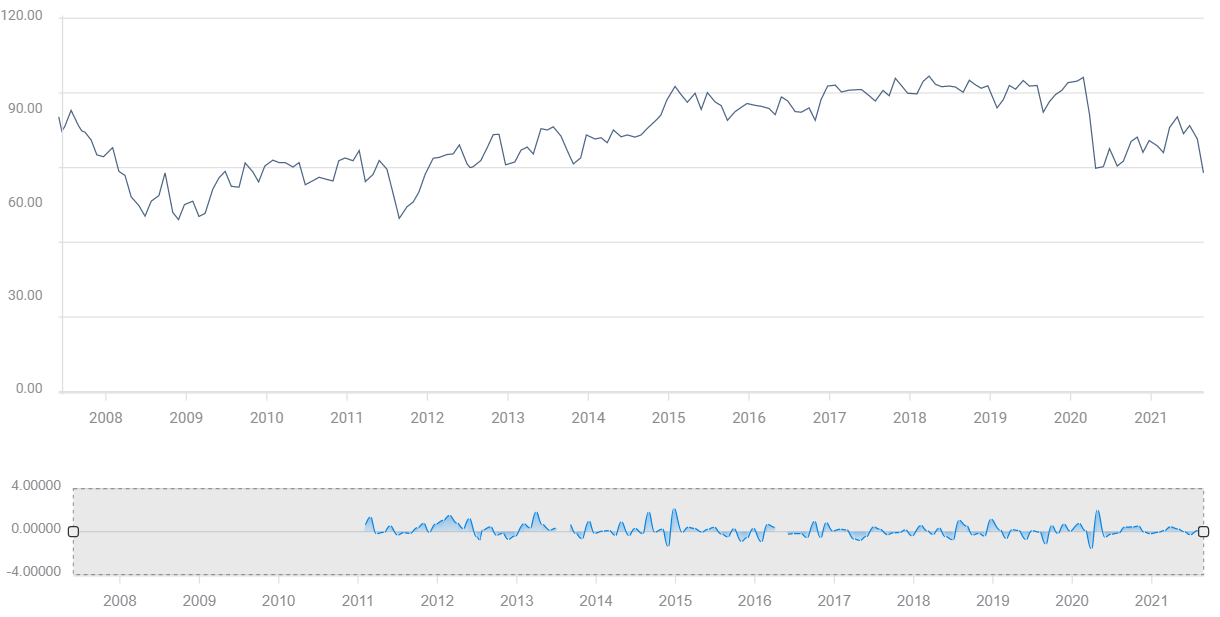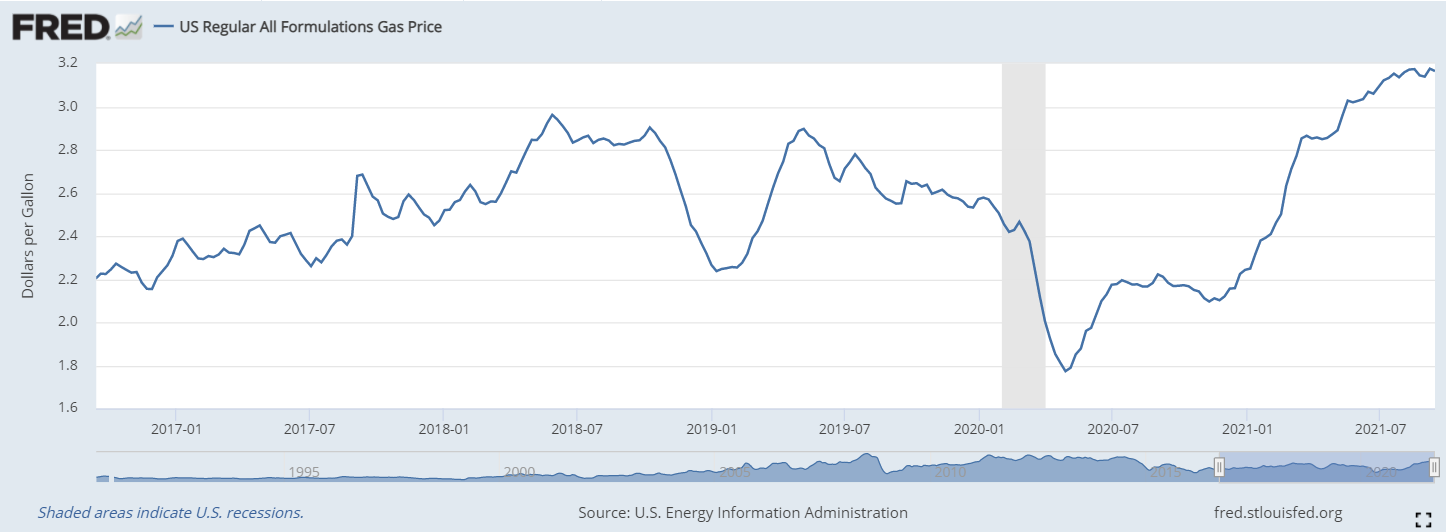- Consumer outlook expected to rebound to 72.2 in September.
- August’s 70.2 was the lowest since December 2011.
- Inflation and Delta variant wearing on US optimism.
- Markets face negative dollar risk from fading consumer optimism.
Americans, troubled by the persistence of inflation and the pandemic, are not expected to have recovered much of their historic optimism after their assessment of the future reached its lowest point in a decade in August.
The Michigan Consumer Sentiment Index, to be released on Friday, September 17th at 14:00 GMT, is forecast to rise to 72.2 in September from 70.3 the month before. Even during the lockdowns of early 2020, the index had only fallen to 71.8 in April.
Michigan Consumer Sentiment
Labor market and inflation
Job creation cooled markedly in August with Nonfarm Payrolls adding just 235,000 positions far less than the 750,00 forecast or the more than one million average of June and July. The Job Openings and Labor Turnover Survey (JOLTS) in July listed 10.9 million open positions, the sixth record month in a row so the paucity in hiring one month later is a bit of an economic puzzle.
JOLTS
Analysts had expected that the September expiration of supplementary federal unemployment benefits would encourage many people to return to work.
Employers may have cut back on hiring after August’s weak Retail Sales but considering the half-year backlog that seems unlikely.
Inflation seems a more promising candidate for the collapse in consumer outlook in August.
Headline inflation has averaged 3.9% this year. Since the first quarter it has measured 5.1%. The staples of food, housing costs and gasoline have seen some of the largest increases. A gallon of regular gasoline has increased 41% this year and 51% since the 2020 presidential election.
August’s Producer Price Index at 8.3% promises continued price increases as manufacturers pass on costs to the consumer.
This sudden and seemingly intractable inflation is bound to make families reassess their budgets and perhaps postpone purchases until prices are more stable.
GDP and Retail Sales
Estimates for third quarter economic growth in the US have dropped sharply in the last month. After averaging more than 6% for most of the summer, the Atlanta Fed GDPNow forecast has fallen to 3.7% in the last two weeks.
GDPNow
Part of this decline reflects the unexpectedly weak Retail Sales figures in July, -1.1% instead of the -0.3% projection. Sales are forecast to fall another 0.8% when August is reported on September 16.
Market reaction to August Consumer Sentiment
The surprise plunge in the Michigan Consumer Sentiment Survey in August to 70.2 (revised to 70.3), far below the 81.2 consensus forecast shocked markets. Interest rates in the US dropped sharply, taking the dollar with them and equities rose with the reduced prospect for a bond taper from the Federal Reserve.
Long-term Treasury rates dropped with the release on August 13. The benchmark 10-year yield fell 7 basis points, closing at 1.297%. The 30-year return tumbled 6.5 points to 1.948%. In contrast the 2-year yield slipped 1 point to 0.215%.
Dollar rates fell with Treasury yields. The Eur/USD gained about three-quarters of a figure to 1.1796. The USD/JPY fell from 110.40 on September 12 to 109.60 the next day.
Equities rose modestly with the S&P 500 adding 0.7% to 4,468.00
Conclusion
The US economy and GDP is based on consumption. If consumers are not happy, they will pull back on spending until the future has a more optimistic focus.
Rising prices are reducing the purchasing power of American families. Inflation-adjusted Average Hourly Earnings fell 0.9% on the year in August following a 1.2% drop in July.
The inflation threat to consumption is underlined by the recent drop in the Atlanta Fed’s GDPNow estimate and the decline in Retail Sales.
The prospect of 3%-4% core inflation and 4%-5% headline CPI for the next six months or a year, is likely to have a greater negative impact on consumer optimism and spending than any number of open jobs.
The persistence of the Delta variant is also taking an unknown toll on consumer confidence. Although case and hospitalization rates have begun to decline, the possibility of yet another wave remains to depress outlook. It will take many months for this drag to wholly dissipate.
For the US growth outlook, a prolonged period of low consumer optimism is the chief danger. If consumers decide that the uncertain future demands a pull-back on spending, the recovery will quickly peter out.
The market risk for the Michigan Sentiment is decidedly negative. If sentiment falls it takes US economic prospects down with it and Treasury rates and the dollar will follow. Even equities will find it hard to balance lower interest rates against fading economic growth.
The predicted modest rise in consumer sentiment is hardly an improvement. The unhappy consumer signalled by sentiment numbers near a 10-year low, will not provide the spending needed to propel the economy in the second half of the year.
Consumer sentiment is a warning that all is not well with the US economy.
Information on these pages contains forward-looking statements that involve risks and uncertainties. Markets and instruments profiled on this page are for informational purposes only and should not in any way come across as a recommendation to buy or sell in these assets. You should do your own thorough research before making any investment decisions. FXStreet does not in any way guarantee that this information is free from mistakes, errors, or material misstatements. It also does not guarantee that this information is of a timely nature. Investing in Open Markets involves a great deal of risk, including the loss of all or a portion of your investment, as well as emotional distress. All risks, losses and costs associated with investing, including total loss of principal, are your responsibility. The views and opinions expressed in this article are those of the authors and do not necessarily reflect the official policy or position of FXStreet nor its advertisers. The author will not be held responsible for information that is found at the end of links posted on this page.
If not otherwise explicitly mentioned in the body of the article, at the time of writing, the author has no position in any stock mentioned in this article and no business relationship with any company mentioned. The author has not received compensation for writing this article, other than from FXStreet.
FXStreet and the author do not provide personalized recommendations. The author makes no representations as to the accuracy, completeness, or suitability of this information. FXStreet and the author will not be liable for any errors, omissions or any losses, injuries or damages arising from this information and its display or use. Errors and omissions excepted.
The author and FXStreet are not registered investment advisors and nothing in this article is intended to be investment advice.
Recommended Content
Editors’ Picks

AUD/USD languishes near multi-year lows below 0.6250 after dovish RBA Minutes
AUD/USD remains depressed below 0.6250 early Tuesday after the December RBA Minutes reiterated that upside inflation risks had diminished, which reaffirms bets for a rate cut in early 2025. This, along with concerns about China's fragile economic recovery and US-China trade war, undermines the Aussie and weighs on the pair.

USD/JPY eases toward 157.00 after Japanese verbal intervention
USD/JPY has come under renewed selling pressure, easing toward 157.00 after Japanese Finance Minister Kato's verbal intervention. The pair erased early gains, induced by the October BoJ meeting Minutes. However, the downside could be limited as the US Dollar hold the previous rebound.

Gold remains stuck between two key barriers amid thin trading
Gold price is attempting another run higher while defending the $2,600 threshold early Tuesday. In doing so, Gold price replicates the recovery moves seen in Monday’s trading, which eventually fizzled out on a broad US Dollar comeback in tandem with US Treasury bond yields.

Solana dominates Bitcoin, Ethereum in price performance and trading volume: Glassnode
Solana is up 6% on Monday following a Glassnode report indicating that SOL has seen more capital increase than Bitcoin and Ethereum. Despite the large gains suggesting a relatively heated market, SOL could still stretch its growth before establishing a top for the cycle.

Bank of England stays on hold, but a dovish front is building
Bank of England rates were maintained at 4.75% today, in line with expectations. However, the 6-3 vote split sent a moderately dovish signal to markets, prompting some dovish repricing and a weaker pound. We remain more dovish than market pricing for 2025.

Best Forex Brokers with Low Spreads
VERIFIED Low spreads are crucial for reducing trading costs. Explore top Forex brokers offering competitive spreads and high leverage. Compare options for EUR/USD, GBP/USD, USD/JPY, and Gold.



